Now that we’ve made the first round of seed introductions, it’s now time to continue down the receiving line. As mentioned in the previous post, I chose many red flowers — but I also included some experiments, seeds that could prove challenging.
First up, an experiment. I always try to include Coleus in the garden. The variety of colors and leaf textures are amazing — and they’re super easy to root if you’d like to save your favorites as houseplants. Simply snip off a stem, place in water, and roots appear. (By the way, that’s also an economical way to keep a favorite Coleus around for the winter months. As the weather warms, take some clippings from that house plant and have roots ready for the outdoor growing season.)
This year, though, I’m trying my hand at Polka Dot Plant. I’ve seen it in some of the box stores, usually sold as a house plant — so why not grow some for the pots around the yard. Besides, it helps satisfy my belief that color doesn’t always have to come from flowers.
There is a trellis outside of the potting shed where “Nelly Moser” Clematis grows. But once it peters out, I usually have Morning Glory climbing upwards. This year, with the theme of red, “Scarlet O’Hara” will be the belle of the ball.
Some flowers simply make me smile. That was my reaction when I spotted the pom-poms of Sweet Scabious in the Select Seeds catalog. Here is “Summer Fruit.”
Here we have Lisianthus, and this was a complete impulse purchase. I was familiar with this plant in pinks and blues — but never red, “Athena Red” to be exact. Even though the catalog image is a posed bouquet shot, I am excited to see what this plant will do in the garden.
I never know what to plant in the front yard beds, which have full southern exposure. Perennials provide a lot of the interest, but I also like to add some annual color. This year, I’m going with “Flare” Salvia because it’s easy to care for and looks great when planted en masse.
Dahlia is another one of my favorites. Normally, I purchase clumps from catalogs, but am I the only one who has noticed the dramatic rise in prices? The answer, then, is seeds. What’s interesting about growing Dahlia from seed is that tubers will develop over the course of the growing season, which can then be saved for next year’s garden. Here we have “Bishop’s Children,” bicolor blooms against purple-black foliage.
And now for the final experiment: Hardy Cyclamen, “Silverheart Scarlet” Hybrid. Primarily sold as a house plant, I’m curious to see how they will manage outside. And, yes, at least one will be my office buddy over the winter months.
Looking at the seeds against the ruler and then at the final result, I can’t help but be in awe of the power of the seed. All that beauty and joy and promise locked up inside — and it can all be enjoyed for a matter of cents. If you haven’t grown anything from seed, please give it a try. There are many easy seeds (Zinnia, Cosmos, Sunflower, and many vegetables and herbs) that can be planted where you’d like them to grow.
And if you do start plants from seed, have a wonderful, bountiful growing season.

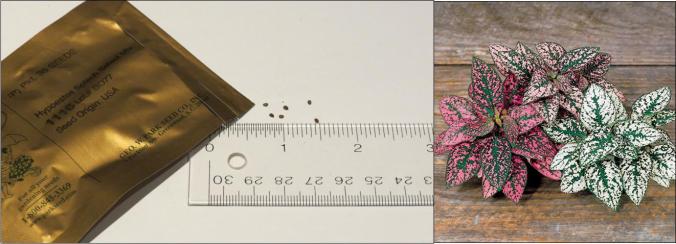
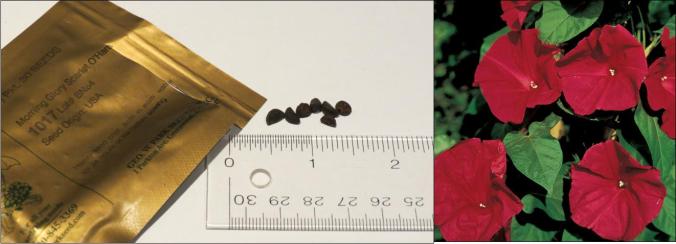

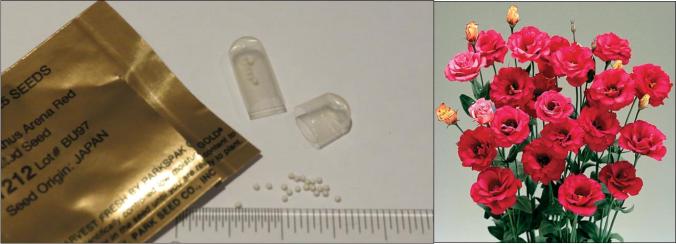
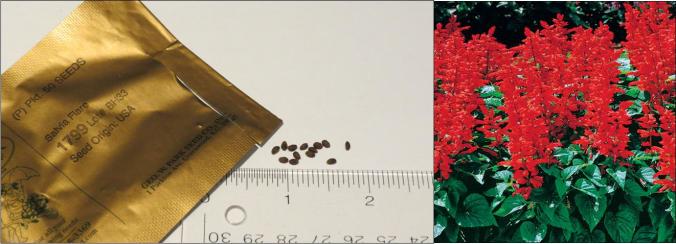
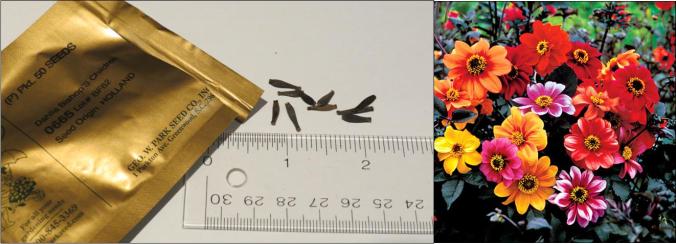
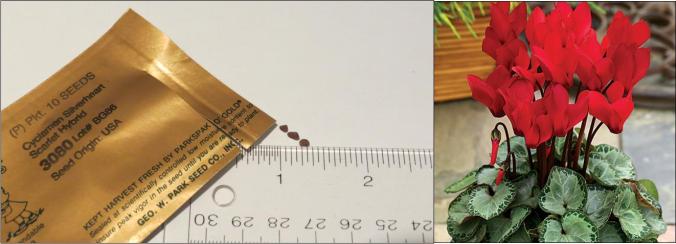
Great photos. We will have a green room, free-standing shed with screens and flaps on all 4 sides, for first time this spring. Hope to use it for starting seeds.
Thanks. I wish you the best with your new shed — starting from seed takes gardening to a whole new level.
I too love to incorporate Coleus where ever I can. Glad to see all the red selections. Should make for some stunning compositions.
Hi Mario — I’m hoping the actual flowers will be as beautiful as the catalog photos. You know how those flower models can be — all of those demands for airbushing. Divas, every last one of them.
So many gardener to gardener questions, but I’ll restrain myself to two: In what region of the country do you garden? Do you use heat and/or lights for your seed starting trays?
Looking forward to the progress reports.
I live in Zone 6 or 7, depending on the map. I know there is the new map, but I’m going by what I observe. Anyway, to start seeds, I use bottom heat. Most seeds are under the ground and do not need light to germinate. Light comes in handy after they break through the surface. When I started seeds in the house, I had rigged up desk lamps — now, I rely on the sun. In a few weeks when I start, I promise to document all of it.
Dahlias are such beautiful plants – I’ve never grown them from seed before so I’d be very interested to give this a go!
It’s really not that difficult — but they do not get as large as the dinner plate variety. If you want color, though, Dahlias can’t be beat. Best of luck with your planting!
Good luck with your seeding adventures. I would be very partial to that beautiful red Cyclamen. Love Dahlias too but our soil is too wet for them.
Sad that you can’t enjoy Dahlias, but there is much to be grateful for in your part of the world. I do hope the Cyclamen are a success.
I remember growing coleus from seeds as a kid, we had a sunny porch and they loved it in there, more of an indoor plant for us 🙂
I also enjoyed Coleus as a house plant — but a full pot in the garden is amazing. Hope you can give it a try.
I will be interested to see what level of success you enjoy with the Dahlia and the Cyclamen. What a score if they develop well…I’m thinking gifts! I have been forbidden (husband) from sowing Cosmos ever again! They really did take over, which you wouldn’t think could be a problem, but they sure did dominate the landscape for a couple of years! I will look forward to your summer garden! Debra
I also have a Cosmos issue. In fact, this year I had to make a conscious effort to have a garden that is Cosmos free. I hope I can hold out. 🙂
BAH!!! My bag of seed compost is just about thawed out…the snow has gone…HOORAH!!!
So exciting to finally get going…interesting seed choice, especially the cyclamen…now that is exciting! x
Happy to hear that you’re defrosting. Enjoy your planting and stay tuned for updates.
Wow!! Those are all just simply gorgeous and now I can’t wait to see photos of the blooms in just a “little” while. I’ve got to hunt up & plant the caladium bulbs I bought but never planted last year–winter sowed 300 milk jugs so I had just a few too many to have any spare time for annuals/potted plants/other things. The cyclamen is drop-dead gorgeous so I wish you great success with that one especially (along with all the others).
Those scabious are so colorful–I didn’t know there was an annual type. Learn some gardening thing new every day!
I love Caladium — another fine example of foliage as a source of color. That reminds me, I have to purchase some. Thanks or the reminder. Happy planting!
Hi Kevin, I had a cyclamen for 6 years outdoors, bought as a houseplant, but once placed in the garden it never came indoors again. It became absolutely huge! It needs to be kept fairly dry after it’s finished flowering and the leaves has gone off, which will happen in May or so, depending on temperature. Don’t let it dry out, but if it gets too wet it will rot, which is what happened to me one particularly wet summer. It wasn’t the winters that killed it, it was a wet London summer. Good luck!
Wow. Thanks for the advice. I’ll give it my best shot. I’ll be happy with at least one flower. Be well!
Yes, seeds are amazing! I love planting them…forgetting about them…and then being surprised when beautiful plants start sprouting up. I’m not the finicky gardener type person, but I do enjoy plants and flowers (if they are hardy and don’t require me to baby them). They make me happy…especially my irises. I can’t wait for spring.
Irises are a treat. At some point,I would like to convert my annual beds into perennial beds, and I plan on including irises — but which to choose? There are so many colors and combos. Hmmmm. Happy gardening!
Kevin, I love the red morning glories.
I just want to thank you again for the Versatile Blogger award and to let you know that I have finally followed all the rules in today’s post at http://enclosuretakerefuge.wordpress.com/2012/02/17/having-many-aspects-uses-or-abilities/
Best regards, Cindy
It’s a very demanding award, but you definitely deserve it. Hope things have calmed down from the Freshly Pressed experience. Enjoy your day!
I love that scarlet cyclamen. How wonderful it would be to have both outdoor and indoor versions!
I was just in a garden center and saw a very similar cyclamen for sale — in full bloom! Now I really can’t wait to get started!